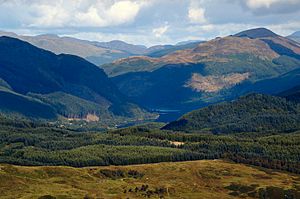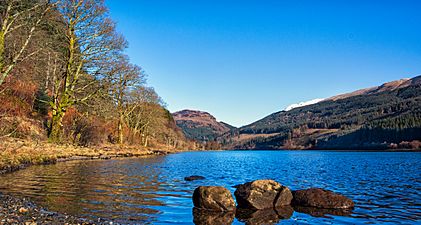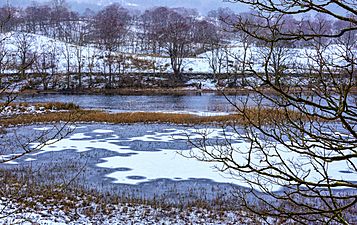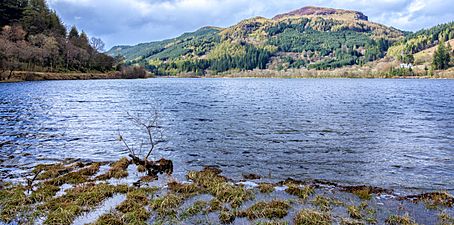Loch Lubnaig facts for kids
Quick facts for kids Loch Lubnaig |
|
|---|---|
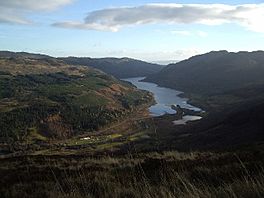 |
|
| Location | Perthshire, Scotland |
| Coordinates | 56°17′29″N 4°17′30″W / 56.2913°N 4.2918°W |
| Type | freshwater loch |
| Primary inflows | River Balvaig |
| Primary outflows | Garbh Uisge |
| Max. length | 6.437 km (4.000 mi) |
| Max. width | 0.38 km (0.24 mi) |
| Surface area | 232.4 ha (574 acres) |
| Average depth | 20.5 ft (6.2 m) |
| Max. depth | 146 ft (45 m) |
| Shore length1 | 14.6 km (9.1 mi) |
| Surface elevation | 121 m (397 ft) |
| 1 Shore length is not a well-defined measure. | |
Loch Lubnaig is a beautiful freshwater loch (which is the Scottish word for lake!) located near Callander in Scotland. It's part of the stunning Loch Lomond and The Trossachs National Park, a special area known for its amazing nature. The loch is nestled between two impressive mountains, Ben Ledi and Ben Vorlich.
The name Loch Lubnaig comes from the Gaelic word Lùbnaig, which means crooked. This name perfectly describes the loch's interesting, winding shape.
Activities and Nature
Loch Lubnaig is a great spot for outdoor adventures. The River Balvaig flows into the loch from the north, and the Garbh Uisge river flows out to the south.
- Fishing: You can enjoy fishing from the shore of the loch. It's a peaceful way to spend time outdoors.
- Canoeing: If you love being on the water, you can rent canoes at the north end of the loch. There are also two car parks on the east side, which are perfect places to launch your own canoe. These spots can get busy, especially on nice days!
Cycling and Walking Paths
The path of an old railway line, called the Callander and Oban Railway, runs along the west side of Loch Lubnaig. This old railway route has been turned into a part of the National Cycle Network's "Route 7".
This means you can cycle or walk for about 9 miles (14 km) between Callander and Strathyre, enjoying fantastic views of the loch and the surrounding mountains. It's a popular route for both cyclists and walkers.
About the Loch's Depths
Loch Lubnaig is quite unique compared to other lochs nearby because its bottom isn't smooth and even. Instead, it's very irregular, with lots of bumps and dips. Imagine a wavy surface rather than a flat one!
Sometimes, you'll find deep water very close to the shore, while in other places, the water stays shallow for a long way out. Even though it's a long loch, it's quite narrow. About two-thirds of the loch is less than 50 feet (15 m) deep.
The loch can be thought of as two main parts, separated by a narrower section in the middle. Each part has its own deeper areas. The deepest part of the loch is about 146 feet (45 m) deep, which is like stacking more than 12 double-decker buses on top of each other!
On the western shore, there's a sandy area that stretches out into the middle of the loch. It's a cool feature to spot if you're exploring the area.
Images for kids



